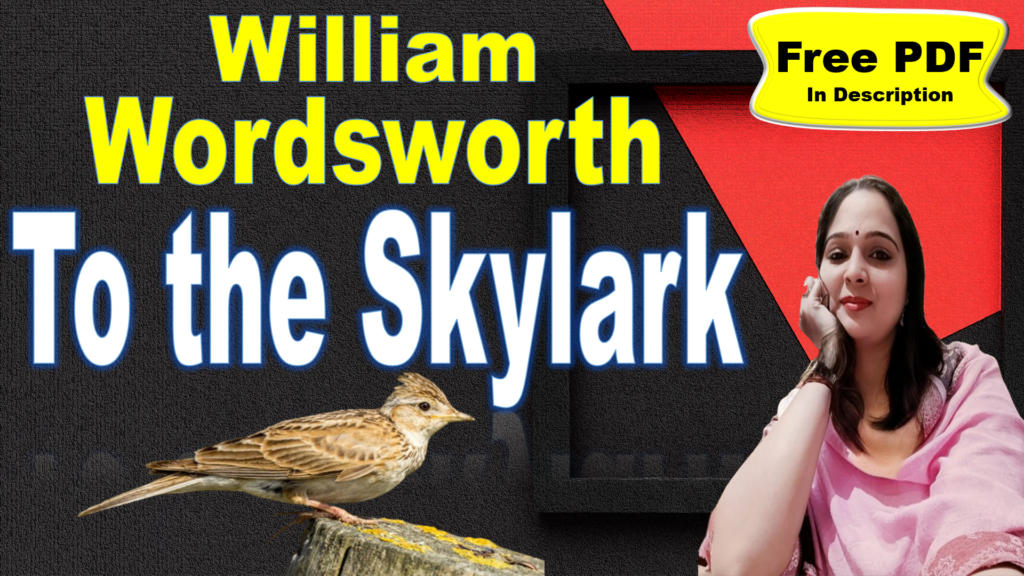
Q: Who wrote “To the Skylark”?
A: William Wordsworth.
Q: What is the primary subject of “To the Skylark”?
A: The skylark bird.
Q: In which collection was “To the Skylark” first published?
A: Yarrow Revisited and Other Poems.
Q: What does the skylark symbolize in the poem?
A: Spiritual aspiration and wisdom.
Q: Which bird is contrasted with the skylark in the poem?
A: The nightingale.
Q: What environment is the nightingale associated with in the poem?
A: A shady wood.
Q: How is the skylark’s environment described?
A: A privacy of glorious light.
Q: What literary device is used when the speaker addresses the skylark directly?
A: Apostrophe.
Q: What is the rhyme scheme of “To the Skylark”?
A: ABABCC.
Q: What does the phrase “pilgrim of the sky” imply about the skylark?
A: It suggests a spiritual journey.
Q: How does the skylark’s song affect the world according to the poem?
A: It pours a flood of harmony upon the world.
Q: What does Wordsworth admire about the skylark’s nature?
A: Its ability to soar while staying connected to its nest.
Q: What theme does the skylark embody in the poem?
A: The balance between aspiration and groundedness.
Q: How is the skylark’s song described in terms of its origin?
A: As instinct more divine.
Q: What does the skylark remain “true” to, according to the poem?
A: The kindred points of Heaven and Home.
Q: What tone is conveyed in “To the Skylark”?
A: Reverent and contemplative.
Q: What poetic device is used to compare the skylark’s and the nightingale’s habitats?
A: Contrast.
Q: What does the nightingale symbolize in contrast to the skylark?
A: Secluded beauty and introspection.
Q: What kind of wisdom does the skylark represent?
A: Wisdom that soars but remains rooted.
Q: What does the poem suggest is essential for true wisdom?
A: Balancing high aspirations with staying grounded.
Short Answer Questions
(To the Skylark by William Wordsworth)
Q: How does Wordsworth contrast the skylark with the nightingale in the poem?
A: Wordsworth contrasts the skylark with the nightingale by associating the nightingale with a “shady wood,” representing darkness and seclusion, while the skylark is linked to a “privacy of glorious light,” symbolizing openness, divinity, and spiritual elevation. The skylark’s song is described as pouring out over the world, while the nightingale’s song remains hidden, reflecting different aspects of beauty and wisdom.
Q: What does the skylark symbolize in “To the Skylark”?
A: The skylark in “To the Skylark” symbolizes spiritual aspiration, wisdom, and the balance between reaching great heights and remaining grounded. It represents an ideal of living where one can aspire to the heavens while staying connected to earthly responsibilities and origins, embodying the harmony between ambition and stability.
Q: How does Wordsworth use imagery to depict the skylark’s environment?
A: Wordsworth uses vivid imagery to depict the skylark’s environment, describing it as a “privacy of glorious light,” where the bird soars in the open sky, filling the world with a “flood of harmony.” This imagery contrasts with the “shady wood” of the nightingale, emphasizing the skylark’s connection to light, divinity, and the vast openness of the heavens.
Q: What is the significance of the skylark being described as a “Type of the wise who soar, but never roam”?
A: This description highlights the skylark as a symbol of those who aspire to great heights (soar) but do so with purpose and direction (never roam). It reflects the idea that true wisdom involves aspiring to spiritual and intellectual elevation while remaining grounded and connected to one’s roots, avoiding aimless wandering or detachment.
Q: In what way does Wordsworth personify the skylark in the poem?
A: Wordsworth personifies the skylark by attributing human-like qualities to it, such as wisdom, spiritual aspiration, and a divine instinct. The bird is portrayed as a “pilgrim of the sky” and a “minstrel,” suggesting that it has a conscious, purposeful journey and the ability to create and share beauty through its song, much like a wise and inspired human.
Q: How does the rhyme scheme of the poem contribute to its overall effect?
A: The ABABCC rhyme scheme of “To the Skylark” creates a harmonious and balanced rhythm that mirrors the poem’s themes of balance and harmony in life. This regularity in the rhyme scheme reinforces the serene and contemplative tone of the poem, reflecting the skylark’s peaceful and purposeful existence.
Q: What is the message Wordsworth conveys through the skylark’s relationship with its nest?
A: Wordsworth conveys that even as the skylark aspires to great heights, it remains connected to its nest on the ground. This relationship symbolizes the importance of staying grounded and true to one’s origins and responsibilities, even while pursuing lofty goals. The skylark’s ability to return to its nest “at will” represents the ideal balance between ambition and rootedness.
Q: How does Wordsworth explore the theme of nature and spirituality in the poem?
A: Wordsworth explores the theme of nature and spirituality by depicting the skylark as a divine being whose song connects the earthly and the heavenly. The bird’s ability to soar in “glorious light” and pour “a flood of harmony” onto the world suggests that nature itself is a source of spiritual wisdom and inspiration, with the skylark serving as a bridge between the natural and the divine.
Q: What role does the nightingale play in the poem, and how does it contrast with the skylark?
A: The nightingale in the poem represents traditional beauty, introspection, and seclusion, singing in a “shady wood.” It contrasts with the skylark, which embodies openness, spiritual elevation, and the sharing of divine wisdom. The nightingale’s association with darkness and privacy highlights the skylark’s connection to light and the expansive reach of its song, emphasizing different aspects of nature’s beauty and wisdom.
Q: How does Wordsworth’s use of metaphors enhance the meaning of the poem?
A: Wordsworth’s use of metaphors, such as “ethereal minstrel” and “pilgrim of the sky,” elevates the skylark from a mere bird to a symbol of spiritual and intellectual aspiration. These metaphors enhance the poem’s meaning by portraying the skylark as a wise being that embodies the ideal of balancing high aspirations with staying connected to one’s roots, making the bird a powerful symbol of wisdom and harmony.





